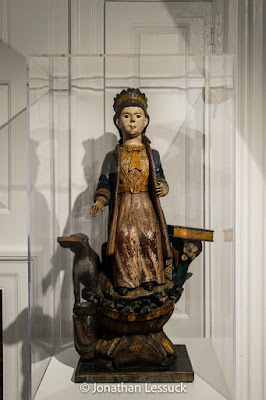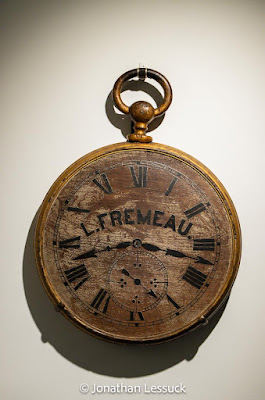There are “museum villages” across the country. They can be wonderful places to learn about local history, culture, and lifestyles. The Shelburne Museum, in Shelburne Vermont, goes a step further than most of its contemporaries, it offers excellent artwork on view for its visitors.
The Shelburne Museum was founded by Electra Havemeyer Webb (1888-1960). Webb was the youngest child of Henry Havemeyer, president of the American Sugar Refining Company, and Louisine Elder Havemeyer. Her parents were collectors of impressionist art, filling their apartment in New York City with paintings from that era. As an adult, she began collecting New England furniture and craftwork, which she used to decorate a farmhouse belonging to her in-laws.
 |
| Electra Havemeyer Webb by Shelburne Museum, CC BY-SA 4.0, via Wikimedia Commons |
In 1947, Electra Webb decided to form a museum to house her collection of horse-drawn carriages. She quickly realized her potential to create a “collection of collections.” She began to acquire buildings from across New England and New York, and bring them to the grounds of her museum, in Shelburne, VT. She looked for buildings of historic significance, and that would be appropriate homes to her collections of American Arts and Crafts
Today, the Shelburne Museum highlights all facets of its collection. Its 45 acres are home to 25 historic buildings, along with 14 others , that cover a wide history of New England architecture. For example, the Round Barn was built in Pessumpsic VT, in 1901. The one-room school house was constructed in 1840 in Vergennes VT. The lighthouse on site began service in 1871 on Lake Champlain, and it sits near the Ticonderoga, a steamboat the used to ply those waters.
The Shelburne Museum has several collections of New England arts and crafts. I enjoyed the collection of folk art, which is housed if the Stagecoach Inn. There are weather vanes, ship carvings, and store signs among many other examples of folk art to enjoy.
 |
The Stagecoach Inn
|
 |
Eagle by Laban Smith Beecher
|
 |
Jack Tar Ship's Chandler Sign
|
 |
Liberty by Eliodoro Patete
|
 |
Liberty Weathervane pattern by Cushing & White
|
 |
Louis Fremeau Jewelers
|
My favorite collection are the Impressionist paintings in the Electra Havemeyer Webb Memorial Building. This greek revival structure was constructed on-site, based on a house in Orwell VT, and its interior was designed as a recreation of six rooms in her apartment in New York City. Here, the paintings that Electra’s parents collected are displayed as they originally were. The collection includes works by Manet, Degas, and Monet, among others, along with a wonderful portrait of Electra and her mother painted by Mary Cassatt.
 |
Electra Havemeyer Webb Memorial House
|
 |
Two Dancers by Edgar Degas
|
 |
The Coiffure by Mary Cassatt
|
 |
In the Rehearsal Studio by Edgar Degas
|
 |
The Drawbridge, Amsterdam by Claude Monet
|
 |
The Greek Girl by Jean-Baptiste-Camillo Corot
|
 |
Blue Venice by Edouard Manet
|
 |
In The Garden by Edouard Manet
|
 |
Ice Floes by Claude Monet
|
 |
Thames at Charing Cross Bridge by Claude Monet
|
 |
Grainstacks, Snow Effect by Claude Monet
|
 |
Louisine Havemeyer and her Daughter Electra by Mary Cassatt
|
The Pleisner Gallery offers a rotating exhibit of paintings by Ogden Pleisner, staged in a recreation of his home studio. It also houses temporary exhibits. During my visit it offered works by Stephen Huneck, whose whimsical depiction of the lives of pets were a joy to see.
 |
Pliesner Gallery
|
 |
Greetings by Stephan Huneck
|
 |
The Waiting Room by Stephen Huneck
|
What museum village would be complete without a general store. The A. Tuckaway General Store was built in 1840 to serve as the post office for Shelburne VT. It was moved to the museum in 1952. The Apothecary House was added to the structure in 1959. Together, they offer offer a slice of New England life in the 19th century.
The Pizzagalli Center for Art and Education is the one modern looking building on the campus of the museum. With a state of the art auditorium, 200 square feet of class room space and two large galleries, it is an excellent home to rotating exhibitions. On my visit I saw “Objects of Play” which examined the work of two toy designers, Karen Hewitt and Cat Holman. Both played a role in developing toys that were meant to used in open-ended play, without specific instructions on how to use them. This allows children to explore and learn in their own way and at their own speed.
 |
Photo from www.shelburnemuseum.org
|
The Shelburne Museum is a destination in it own right. It offers a reason to visit the Burlington Area, and it is worth a day to see it completely.
















































Comments
Post a Comment